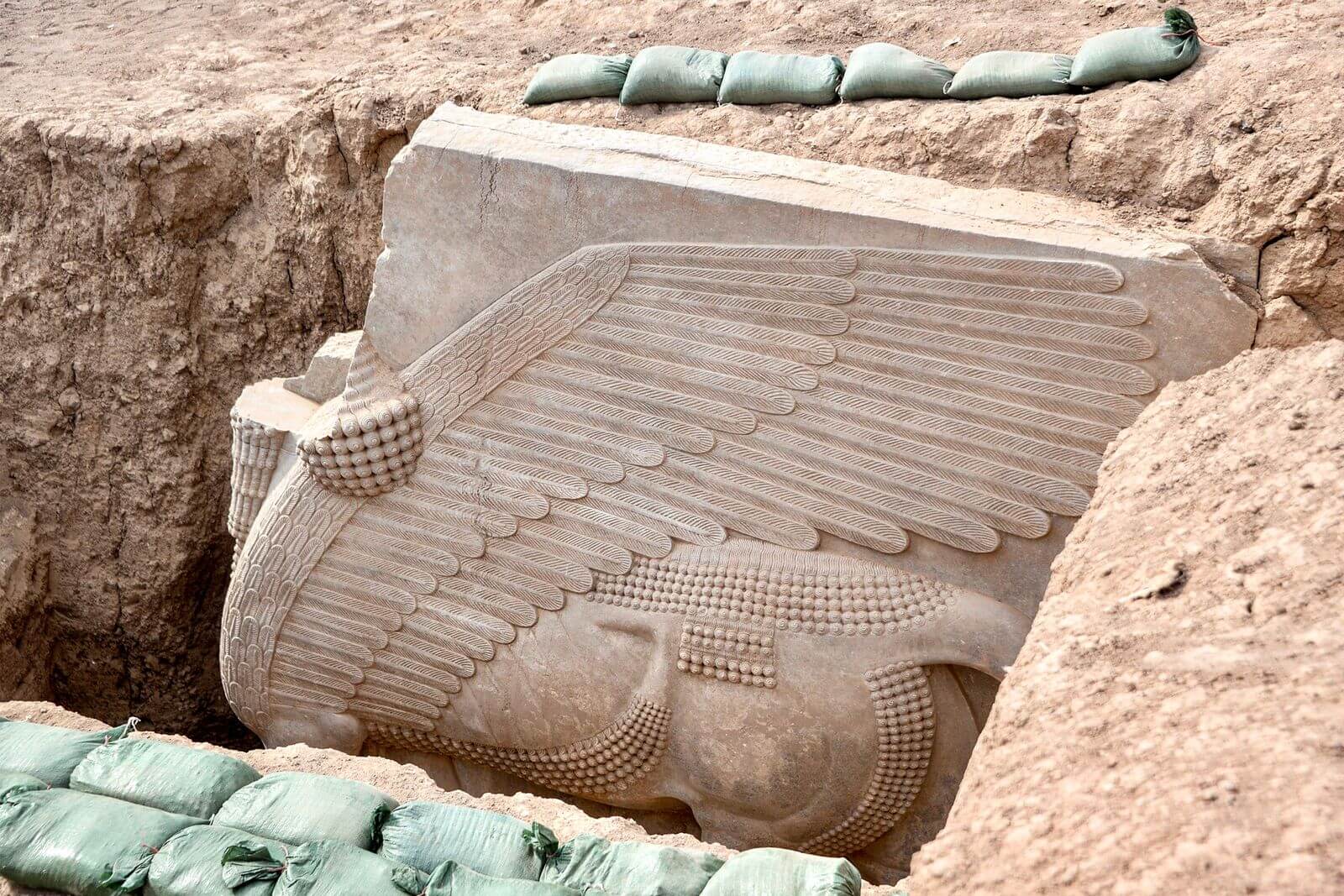
Stunning 2,700-Year-Old Sculpture Unearthed In Iraq
Archaeologists hope to reunite the 18-ton torso of the Assyrian deity with its head, severed by smugglers decades ago
By: Teresa Nowakowski | Smithsonian
With the wings of a bird, the body of a bull and the head of a human, the lamassu is an imposing figure—especially when the Assyrian deity’s form is rendered in 18 tons of alabaster. That’s what French and Iraqi archaeologists have uncovered at Dur-Sharrukin, an ancient city in northern Iraq.
“I never unearthed anything this big in my life before,” says Pascal Butterlin, an archaeologist specializing in the Middle East at the University of Paris I Pantheon-Sorbonne, to Agence France-Presse (AFP). The 2,700-year-old sculpture measures approximately 12.5 by 12.8 feet and remains largely intact—except for its head, which is missing.
Researchers have long known about the sculpture. It first appears in records from 19th century excavations, and several other lamassus found nearby now reside at the Louvre, according to Hyperallergic’s Elaine Velie. The piece wasn’t mentioned again in public records until the early 1990s, when Iraqi authorities officially excavated it.
A few years later, thieves stole the statue’s head, breaking it into pieces so they could smuggle it out of the country. Experts eventually recovered and restored the head, but “cracks from its dismemberment [are] still visible,” reports the Art Newspaper’s Hadani Ditmars.
The Rock Wall of Texas: Is It Really Older Than Any Known Human Civilization On Earth?
Authorities reburied the remaining portion of the statue to safeguard it from looting and attacks. In 2014, residents who lived nearby also helped protect it from destruction by the Islamic State, hiding it before they fled the area, reports AFP.
Now, researchers have recovered the statue’s torso as part of a larger project examining the ancient city and recent military activity, Butterlin tells Hyperallergic. “It was a multi-dimensional archaeology,” says Butterlin of the recent excavation. “It’s the archaeology of conflicts and urban archaeology, and the lamassu is just at the border of both—with multiple lives.”
Commissioned during the reign of Sargon II, the ruler of Assyria between 722 and 705 B.C.E., the statue once stood at the gates of Dur-Sharrukin to provide protection. However, after Sargon died in battle, his son moved the Assyrian capital to Nineveh, “leaving Dur-Sharrukin unfinished and largely forgotten,” writes Hyperallergic.
Today, thousands of years later, experts are impressed by its intricate design. As Butterlin tells AFP, “The attention to detail is unbelievable.”
The team is now brainstorming ways to rejoin the statue’s head and torso, since the neck was damaged when thieves cut off the head, as Laith Hussein, director of the Iraqi State Board of Antiquities and Heritage, tells the Art Newspaper.
Once that process is complete, the sculpture’s ultimate fate is still unclear. In the meantime, the re-excavated torso remains at the site, under tight security and protection from the elements.
* * *
NEXT UP!
What Caused The Historic Fall of Sumer?
Mesopotamia, often referred to as the cradle of civilization, was home to one of the most advanced ancient cultures in the world – the Sumerians. The Sumerians inhabited the land between the Tigris and Euphrates rivers, in what is now modern-day Iraq. This region, known as Mesopotamia, provided fertile grounds for agriculture and allowed the Sumerians to thrive.
Around 4500 BC, the Sumerians developed complex city-states. Each city-state had its own government, ruled by a priesthood as the religious leaders, and its own patron deity.
The centre of each city-state was dominated by a massive ziggurat, a stepped pyramid structure dedicated to their respective deity. These awe-inspiring structures served as religious centres, administrative hubs, and symbols of power.
* * *
READ MORE: Nimrud Lens: Did Assyrians Invent Telescopes 3,000 Years Ago?
More on The Assyrians: 2,800-Year-Old Castle Linked To Enigmatic Ancient Civilization Found In Turkey
Enjoyed it? Please take a moment to show your support for Collective Spark.
We’d love to hear from you! If you have a comment about this article or if you have a tip for a future Collective Spark Story please let us know below in the comment section.
